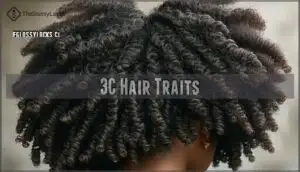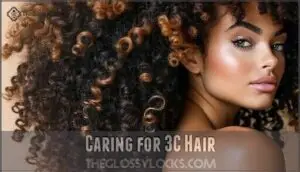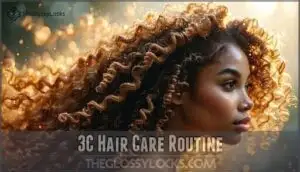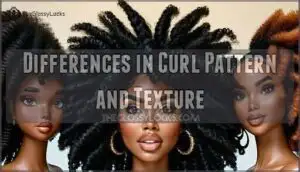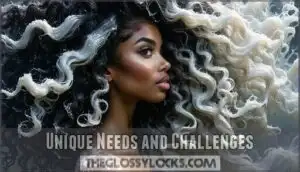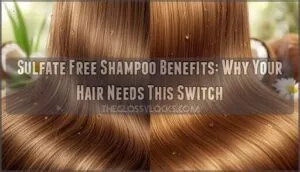This site is supported by our readers. We may earn a commission, at no cost to you, if you purchase through links.
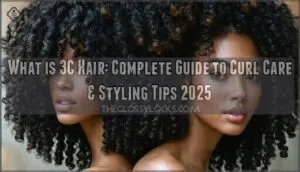
You’ll recognize this curl pattern by its dense, voluminous spirals that sit between loose 3B curls and tighter 4A coils.
Your 3C curls pack serious personality but come with a catch – they’re naturally thirsty.
The corkscrew shape makes it tough for your scalp’s natural oils to travel down each strand, leaving your curls prone to dryness and frizz.
Think of your hair like a twisted straw that needs extra hydration to stay happy.
Understanding what is 3C hair means recognizing its unique moisture needs and learning the right techniques to keep those gorgeous spirals defined and healthy.
Table Of Contents
- Key Takeaways
- Defining 3C Hair
- What is 3C Hair
- 3C Hair Traits
- Caring for 3C Hair
- 3C Hair Care Routine
- 3C Hair Vs Other Curl Types
- Maintaining Healthy 3C Hair
- Frequently Asked Questions (FAQs)
- How do I know if my hair is 3B or 3C?
- Is 3C hair African American?
- Do I have 3C or 4A hair?
- What products are best for 3C hair?
- What are the characteristics of 3C hair?
- How to care for 3C hair?
- What is 2c hair?
- What is 4c hair?
- Can 3C hair be permanently straightened or relaxed?
- How often should you trim 3C curls?
- Conclusion
Key Takeaways
- Your 3C hair features tight, pencil-width corkscrew curls that spring back when stretched and create natural volume, but they’re prone to dryness since oils can’t easily travel down the twisted strands.
- You’ll need to prioritize moisture with sulfate-free shampoos, weekly deep conditioning treatments, and leave-in conditioners since your curls have low porosity and struggle to absorb hydration.
- Your curl pattern sits between looser 3B spirals and tighter 4A coils, giving you maximum styling versatility but requiring more intensive moisture care than other curl types.
- You can maintain healthy 3C curls by using protective styling techniques, sleeping on satin pillowcases, trimming every 8-12 weeks, and focusing on gentle detangling with wide-tooth combs on wet hair.
Defining 3C Hair
If your curls are tightly packed, pencil-sized corkscrews that spring back into an S-shape when stretched, you’ve got 3C hair.
This curl type sits between looser 3B spirals and tighter 4A coils, creating dense, voluminous texture that’s both beautiful and challenging to manage.
Characteristics of 3C Hair
Your 3C hair type showcases tight curls that pack together like springs, creating impressive hair volume and natural bounce.
Your tight corkscrews create that enviable volume and bounce other curl types dream about.
These curls maintain excellent shape retention even when stretched, snapping back to their corkscrew form.
You’ll notice your strand thickness varies, while porosity levels typically run low, making moisture absorption challenging.
This curly hair delivers stunning curl definition with its distinctive spiral pattern, and has excellent shape retention.
Curl Pattern and Texture
Your 3C hair type showcases tight curls with remarkable curl definition that holds its signature S-shaped pattern even when stretched.
The curl pattern features strands about pencil-width, creating natural texture variability throughout your head.
You’ll notice pattern combinations where some areas display looser ringlets while others form tighter corkscrews, giving your hair its distinctive, voluminous appearance due to strand thickness variation.
Hair Porosity and Moisture Retention
Your 3c hair’s porosity levels determine how well it absorbs and retains moisture.
With naturally low porosity, your cuticles resist product absorption, making hydration techniques essential for moisture balance.
This means you’ll need lightweight formulas that won’t create buildup while still delivering essential hair moisture, which is crucial for understanding your hair porosity and choosing products that actually penetrate your cuticle health barriers.
What is 3C Hair
Now that you understand the basic characteristics, let’s get specific about what 3C hair actually is.
Your 3C hair sits right between looser 3B curls and tighter 4A coils, making it the tightest curl pattern in the type 3 category.
Think of it as the Goldilocks of curly hair – not too loose, not too tight, but just right for maximum styling versatility.
Here’s what makes your 3C hair unique:
- Tight corkscrew curls about the width of a pencil or drinking straw
- Dense curl pattern that creates natural hair volume even when short
- S-shaped definition that holds its curl pattern when stretched
- Low porosity structure affecting moisture retention and absorption
- High styling versatility allowing you to achieve various 3C hair styles
Your 3C hair care routine needs to work with these natural curl definition patterns, not against them.
3C Hair Traits
You’ll recognize 3C hair by its tight, pencil-sized corkscrew curls that create impressive volume and maintain their S-shaped pattern even when stretched.
Your curls pack densely together, which gives you that enviable fullness but also makes your hair prone to dryness and frizz since natural oils can’t easily travel down each tightly coiled strand, resulting in a need for specific care to combat frizz.
Curl Width and Shape
Your 3C curls follow a distinctive pattern that’s easy to spot once you know what to look for.
Each strand forms tight corkscrews with a curl diameter matching a pencil or drinking straw.
These curls maintain their S-shape or Z-shape even when stretched, showing excellent shape retention and curl definition that sets 3C apart from other hair types.
| Curl Characteristic | 3C Pattern | Key Identifier |
|---|---|---|
| Curl Diameter | Pencil/straw width | Tight, uniform sizing |
| Shape Pattern | S-shape or Z-shape | Maintains form when stretched |
| Curl Definition | Well-defined spirals | Clear, distinct boundaries |
Hair Density and Volume
Your 3C hair naturally packs more strands per square inch than other hair types, creating impressive volume and fullness.
This high density gives you that coveted thick appearance, but it also means your scalp coverage is excellent.
The strand thickness varies, contributing to your hair’s overall texture and curl definition. Understanding your density helps you choose the right volume styling products and density-specific treatments for the best results.
Prone to Dryness and Frizz
Your 3C hair’s tight curl pattern creates a perfect storm for dryness and frizz.
Natural oils struggle to travel down your corkscrew curls, leaving dry curls vulnerable to humidity effects and breakage.
Without proper moisture and frizz control, product buildup compounds the problem.
Deep conditioning treatments and careful oil selection become your best defense against these daily challenges.
Caring for 3C Hair
Your 3C curls need consistent moisture and gentle care to stay healthy and defined since their tight pattern makes it harder for natural oils to travel down each strand.
You’ll want to focus on hydrating products, sulfate-free cleansers, and protective styling techniques that won’t disrupt your curl structure or cause breakage.
Moisture and Hydration
Your 3c hair craves moisture like a desert needs rain.
Deep conditioning treatments weekly restore your curls’ bounce and definition. Focus on hydration techniques using humectant-rich products that penetrate low hair porosity barriers.
Layer leave-in conditioners before styling to lock in moisture.
Overnight hydration masks work wonders while you sleep, transforming dry, brittle curls into soft, defined spirals with improved hydration techniques and moisture.
Sulfate-Free Shampoos and Conditioners
Traditional shampoos often strip your 3C hair of essential oils, leaving curls dry and brittle.
Sulfate-free shampoos and cleansing conditioners gently clean without harsh detergents, preserving natural moisture your tight curls desperately need.
These gentler hair products maintain your curl pattern while fighting frizz.
Choose sulfate-free alternatives or try clarifying shampoos occasionally for deeper cleansing without compromising your hair care routine. You can even find specialized shampoos available designed for 3C hair to help with hair care routine.
Protecting Curls From Heat and Damage
Heat damage wreaks havoc on fragile 3c hair, turning your beautiful curls into frizzy, brittle strands.
You’ll need strategic protection to maintain healthy texture and prevent breakage.
- Heat protectants – Apply before any styling to create a barrier between tools and hair
- Low-heat styling – Keep temperatures below 300°F to minimize damage risk
- Deep conditioning – Weekly treatments restore moisture lost from heat exposure
- Protective hairstyles – Braids and buns reduce daily manipulation and breakage
3C Hair Care Routine
Your 3C curls need a consistent routine that prioritizes moisture and gentle handling to maintain their health and definition.
You’ll want to focus on three key areas: proper washing and conditioning techniques, strategic use of leave-in products and masks, and protective styling methods that won’t disturb your curl pattern.
Washing and Conditioning
Your 3c hair needs a gentle washing approach that respects its delicate structure.
Wash every 3-5 days using sulfatefree shampoo to preserve natural oils.
Between washes, try cleansing conditioner for revitalizing without stripping moisture.
Focus on scalp health while detangling wet hair with wide-tooth combs.
Choose moisturizing hair products that penetrate deeply, preventing product buildup that weighs down your beautiful curls.
Leave-in Conditioners and Masks
After cleansing your 3c hair, leave-in conditioner becomes your curl’s best friend.
SheaMoisture Jamaican Black Castor Oil excels at defining curls while moisturizing hair.
For deep conditioning, try Mixed Chicks mask weekly – it detangles beautifully.
These protein treatments offer hydration benefits that prevent breakage.
Consider specialized 3c options for ideal results.
Proper application techniques involve working products through damp sections, focusing on mid-lengths and ends.
Styling and Protecting Curls
Once you’ve moisturized your 3C hair properly, styling becomes your creative playground.
Choose protective hairstyles like twist-outs or bantu knots to maintain curl definition while minimizing manipulation.
Apply styling products to damp hair using scrunching techniques for better curl formation.
Many find success with specialized product options for these styles.
At night, protect your curls with a satin bonnet or pillowcase to prevent frizz and preserve your hard work.
3C Hair Vs Other Curl Types
You’ll notice 3C hair falls between looser 3B spirals and tighter 4A coils, with curls that are densely packed yet maintain their S-shaped pattern when stretched.
Understanding these differences helps you choose the right products and techniques, since 3C hair needs more moisture than 3B but offers more curl definition than 4A hair.
Comparison to 3B and 4A Hair
Understanding where your 3C hair fits between neighboring curl patterns helps you choose the right products and techniques.
Your curls sit perfectly between 3B’s looser spirals and 4A’s tighter coils, creating unique styling needs.
| Feature | 3B Hair | 3C Hair | 4A Hair |
|---|---|---|---|
| Curl Definition | Loose spirals, springy | Tight corkscrews, dense | Small coils, springy |
| Hair Volume | Moderate fullness | Maximum volume | High density |
| Moisture Needs | Regular hydration | Intense moisture | Deep conditioning |
Differences in Curl Pattern and Texture
Beyond the basic comparisons lies the real story of what makes each curl type unique.
Your 3C hair shows distinct differences that set it apart from neighboring types on the curl type chart.
The following table highlights the key features of 3B and 3C hair:
| Feature | 3B Hair | 3C Hair |
|---|---|---|
| Curl size | Large springy spirals | Tight corkscrew curls |
| Strand thickness | Medium to thick | Dense, tightly packed |
| Pattern consistency | Loose, bouncy waves | Uniform spiral definition |
| Texture variations | Smooth, glossy finish | Matte, voluminous texture |
| Curl definition | Well-defined but loose | Sharp, pencil-sized coils |
These characteristics demonstrate the unique qualities of 3C hair, including its uniform spiral definition and matte, voluminous texture.
Unique Needs and Challenges
Your 3C hair faces distinct challenges that set it apart from other curl types.
You’ll battle more stubborn product buildup than looser curls, requiring specialized detangling methods and gentle protective styling.
Climate sensitivity means humidity becomes your enemy, while significant shrinkage masks your hair’s true length.
These unique traits demand targeted solutions beyond standard curly hair care approaches, including the use of clarifying treatments and anti-humidity serums.
| Challenge | 3C Hair Impact | Solution Strategy |
|---|---|---|
| Product Buildup | Heavy creams cling to tight curls | Clarifying treatments monthly |
| Shrinkage | Up to 75% length reduction | Stretching techniques, twist-outs |
| Climate Sensitivity | Extreme frizz in humidity | Anti-humidity serums, protective styles |
The solution strategies for these challenges involve using specific techniques, such as stretching techniques and protective styles, to mitigate the effects of product buildup, shrinkage, and climate sensitivity.
Maintaining Healthy 3C Hair
You can maintain healthy 3C hair by focusing on consistent moisture, gentle handling, and regular maintenance that prevents breakage and frizz.
Your tight curls need extra attention with sulfate-free products, protective styling, and routine trims to keep them strong and defined.
Tips for Reducing Frizz and Breakage
Your 3c hair needs smart strategies to combat frizz and hair breakage.
Start with gentle detangling using wide-tooth combs on wet, conditioned hair. Choose protective styles that don’t pull tight.
Nighttime protection with satin pillowcases prevents friction damage.
Look for product ingredients like shea butter and glycerin that boost moisture retention through effective hydration methods.
Importance of Regular Trims and Scalp Care
Regular trims every six weeks keep your 3c hair healthy by removing split ends that cause breakage.
Clean scalp care prevents product buildup that weighs down curls and blocks growth stimulation.
Trim benefits include better curl definition and reduced frizz, focus on scalp health through gentle cleansing – it’s your foundation for strong hair tips that actually work, with strong hair being the ultimate goal.
Frequently Asked Questions (FAQs)
How do I know if my hair is 3B or 3C?
Look at your curl size – 3B curls are pencil-thick spirals with bounce, while 3C curls are drinking straw-sized corkscrews packed tightly together.
3C hair’s denser, more voluminous, and holds its S-shape when stretched.
Is 3C hair African American?
Does your heritage define your hair texture?
3C hair isn’t exclusive to African Americans—it’s found across various ethnicities including mixed-race individuals, Latinos, and people of Mediterranean descent.
Your curl pattern transcends racial boundaries.
Do I have 3C or 4A hair?
Your curl pattern determines the difference. If your curls are pencil-sized corkscrews that hold their S-shape when stretched, you’ve got 3C hair. Tighter zigzag coils with more shrinkage indicate 4A.
What products are best for 3C hair?
Your thirsty 3C curls desperately crave moisture-rich creams, sulfate-free shampoos, and weekly deep conditioning masks.
You’ll need leave-in conditioners, co-wash cleansers, and protective oils to tame frizz and maintain those gorgeous, defined corkscrews.
What are the characteristics of 3C hair?
Your 3C hair features tight, densely packed corkscrew curls about pencil-width.
It’s naturally voluminous with defined S-shaped patterns that spring back when stretched.
You’ll notice significant shrinkage and it’s prone to dryness.
How to care for 3C hair?
Your curls are absolutely parched for moisture.
You’ll need sulfate-free shampoos, deep conditioning masks weekly, and leave-in creams.
Co-wash between shampoos, sleep on satin pillowcases, and trim regularly to prevent breakage.
What is 2c hair?
Hair with type 2C features loose waves that form an S-shape pattern.
You’ll notice it’s thicker than 2A or 2B, with waves starting from your roots and creating more volume throughout.
What is 4c hair?
About 65% of people with type 4 hair have 4C texture.
You’ll recognize 4C hair by its tight zigzag pattern, maximum shrinkage, and incredible volume.
It’s the most fragile curl type, requiring gentle handling and intense moisture.
Can 3C hair be permanently straightened or relaxed?
Yes, you can permanently straighten 3C hair through chemical relaxers or keratin treatments.
However, these processes damage your curl structure and require ongoing maintenance.
Consider heat-free styling methods first to preserve your natural texture.
How often should you trim 3C curls?
Picture scissors snipping away split ends like pruning a garden—your 3C curls need trimming every 8-12 weeks.
Regular cuts prevent breakage from traveling up, keeping your spirals healthy and defined while promoting better growth.
Conclusion
Embracing what’s 3C hair means celebrating your unique spiral crown while mastering its specific needs.
Your curls aren’t high-maintenance – they’re simply selective about their care routine.
With proper hydration, gentle cleansing, and protective styling, you’ll transform frustrating frizz into enviable definition.
Remember that consistency beats perfection every time.
Start with one or two new techniques rather than overhauling everything at once.
Your 3C curls will reward your patience with bounce, shine, and gorgeous natural volume, achieving enviable definition.
- https://www.instagram.com/jadajenkinsco/?hl=en
- https://www.allure.com/gallery/curl-hair-type-guide
- https://www.healthline.com/health/beauty-skin-care/types-of-hair
- https://www.equibotanics.com/blogs/news/3c-hair-type?srsltid=AfmBOoopBVB034OO83s19-KucLQptrEAetzSb3mzhJTh9XXBb35mNsb3
- https://www.mycurlproducts.com/blogs/healthy-natural-haircare/the-benefits-of-routine-trims-for-natural-hair?srsltid=AfmBOooT6iDbQYseWHIBjKLcHTDD1gyO0pWbkvnh7_et-nj6TVyHjt8M

